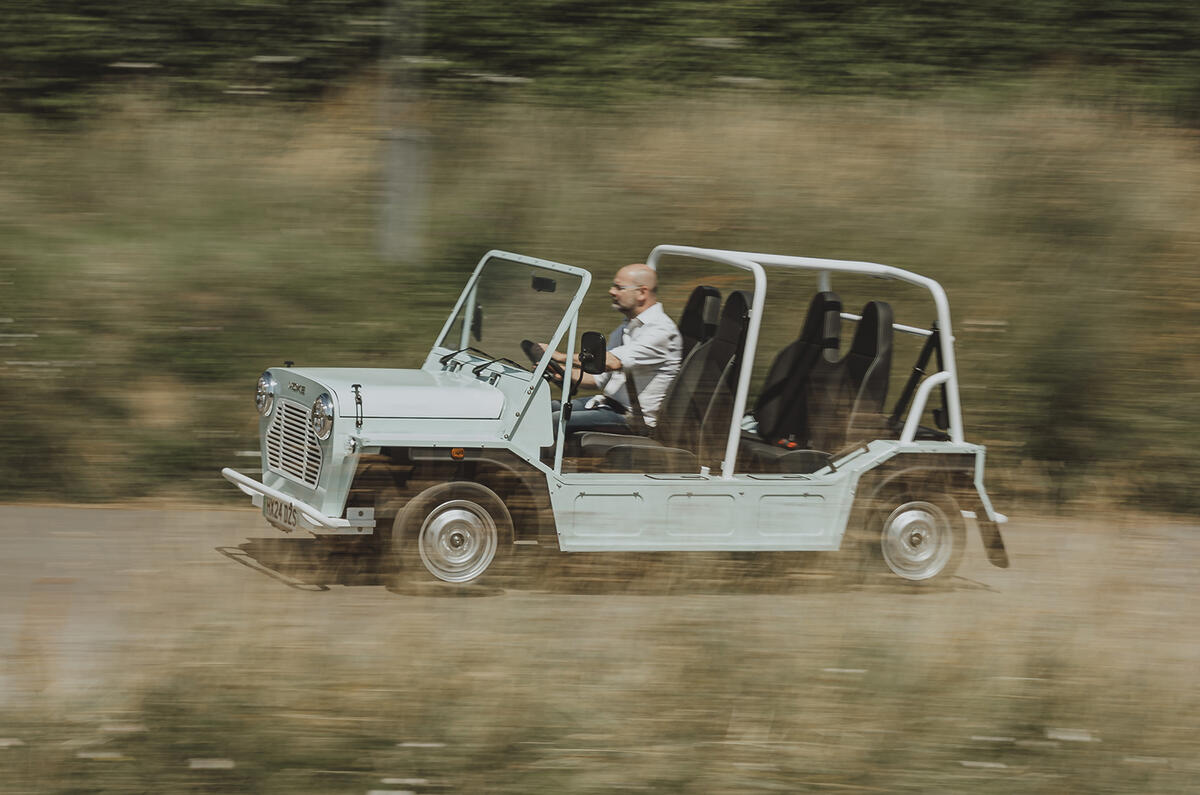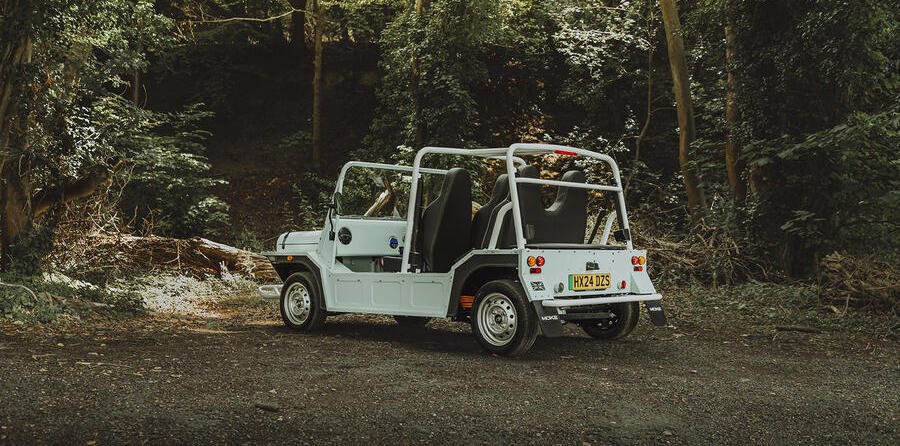One could spend a lot of hours investigating Mini Moke history: between 1964 and 1993 it was built in six countries and it spawned multiple offshoots.
Kit cars, replicas and relaunches: the Moke has seen a few. And it hasn't finished.
"We spend quite a lot of time and money defending this sort of thing," explains Moke International's new executive chairman, Nick English, while a new electric Moke waits for me outside.
In May last year, Moke international - the maker of the car you see on these pages - and Moke America LL.G, which makes something that looks (and indeed is) quite similar, came together, again, in a US court of appeal.
While they vehemently disagreed with each other on many things, predominantly who should own the Moke marque and who used it first, they did both feel that, in an earlier hearing, a judge was wrong to say that the Moke was like aspirin or hovercraft, a trademark that had entered generic use. Moke should not, they said, be a definition like a beach buggy.
And so it goes on. But while you could spend a lot of time on it, today is a sunny day and life's too short.
To recap, then: BMC's Alec Issigonis, designer of the Mini, created the original Moke, using Mini mechanicals, to obtain some more volume for the parts and hoped to pinch Land Rover sales.
BMC pitched the Moke to the army as a car that could be thrown from an aeroplane. The army liked that idea but didn't think so much to soldiers having to carry it over rough ground owing to its poor ground clearance and two-wheel drive, so it continued buying Land Rovers.
The American military wasn't much more impressed, either, when it was shown a four wheel-drive prototype with two engines, deciding that the ground clearance was still poor and that two engines sounded complicated. It carried on buying Jeeps.
A utility version was launched instead, but the taxman not unreasonably decided that was a passenger car - not a commercial vehicle - so purchase tax didn't affect the Moke's sales volumes.
But the fashion set did, when it took rather more kindly to the Moke and turned to it in numbers, treating it how English still describes the modern Electric Moke: as "a second car for second homes.”
Over the years, the BMC Moke variously wore the Austin and Morris and Leyland tags and the rights were eventually sold to motorbike manufacturer Cagiva, which couldn't make it viable and then later went under itself.
The idea was resurrected by China's Chery and Jaguar Land Rover as a potential joint venture in 2012. Designed by industrial designer Michael Young, Chery began producing the Moke in 2013, with final assembly in several different markets. It was then petrol-powered, but Young redesigned the Moke for electric propulsion for Moke International in 2018, which, with some re-engineering, is now the car you see here.
It's Mokey, for sure, but even though it's only 3.33m long and 1.67m wide, that's still a foot longer and wider than the original. The chassis is a steel spaceframe, there's some electrickery under the bonnet, and it has MacPherson struts at the front and a live trailing arm at the rear, where it's driven by a 44bhp, 96lb ft motor.
And even if it's a little bigger and, at 741kg, heavier, it's true to that concept: simple and easy and relatively light.
Still light enough to throw one from an aeroplane maybe (advertising idea if you did fancy it: "we're now delivering them just as Alec imagined..."). It looks inviting and fun.
A canvas roof pops off simply and can be rolled up and stuffed on board, but everywhere one of these lives will have a garage anyway.
There are four seats (the rear bench with Isofix mounts), a heated windscreen, a non-adjustable steering wheel, lights and wiper stalks, plus a bold interior dash panel with marine-grade waterproof toggles and stereo.
And that's about your lot. When the standard specification has 'licence plate lamp', you know you're in the realm of a basic machine.
Cubbies in the side panels hide the charge cable. The battery is unable to be rapidly charged, but that's okay: the official WLTP range is 54 miles so even on a three-pin you're unlikely to be waiting too long for the 10.5kWh battery to juice itself up. Call it the duration of a light lunch and a quick swim.
I make myself as comfortable as I'm likely to be. I'm holding the steering wheel at a similar height as a plate at a buffet, I hit the drive button on the floor and start to pull away.
There's an audible whirr at low speeds that disappears once you're rolling more convincingly. I think it's there to warn bystanders of your presence around town, but they all see it coming and know precisely what it is anyway.
"Moke!" goes the shout, from the young, the elderly, the inbetween. Curious how a car that wasn't a big hitter even in its heyday remains so well known.
Is it a looker? I'm not sure it ever was. But the proportions are similar enough to the original's and there's such familiarity about it, like a series Land Rover or an original Mini, that it's hard to really know whether it's actually attractive or not. It's certainly reassuring. And well liked. If we all drove one of these I contend road rage wouldn't exist.
We would have a decent time of it too. The steering is 2.75 turns lock to lock and unassisted, pedal weights are good (there are different drive modes but, honestly, there's not much in it) and the brakes are also unassisted and without ABS: there are discs at the front, drums at the rear, but given the top speed is 50mph, a Rimac Nevera this is not.
The tyres are Davanti 165/65 R13s, springs are coils all around and the ride is fine, you know.
One would imagine the big roll-cage stiffens up the torsional rigidity nicely, and it would be pretty flexy without it, but it rolls with amiable absorbance and just a little bounce here and there to keep you alive.
The steering is direct, accurate and there's a general karty kind of feel to driving the Moke that I like a great deal.
What it won't do is get you very far. Moke International says that 'real-world' testing in cities and coastlines produces 45-80 miles, and on a small, slow island I can believe it - the biggest collection of Mokes is in St Barts in the Caribbean.
By comparison, the UK is quite a big and fast island so I'm on to get 50 miles and no more, and when I'm up towards 50mph, wind whips around the screen into your face. Little deflectors like you can have on a Caterham would be an idea. It might be nicer still if the screen folded flat.
And with that sort of use in mind, the electric Moke is an extremely likeable thing. Winter would be a nuisance, of course, but that's not the point.
Moke International will build 500 of them this year, says English, and has "quite a big backlog" of orders for the car too.
They're priced at £35,995 on the road in the UK. English is a co-founder of Bremont watches, and while acknowledging that the Moke will never be a really expensive object, he is aware that "we should be doing more bespoke stuff too". There are two special editions already and more in the pipeline.
So, an electric car that can't fast-charge, won't do more than 50mph and won't go more than 50 miles and that has no doors, no heater, a paucity of safety kit and costs more than two Dacia Springs. Do I recommend one? Pfft. I think we should all have one.

Noticias relacionadas

